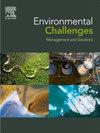Recycling of volcanic ash and carbide slag in blended mortars: A multi-criteria performance assessment
Q2 Environmental Science
引用次数: 0
Abstract
A multi-criteria performance evaluation was performed to assess the physical and durability properties of cementitious composites containing volcanic ash (VA) and carbide slag (CS). The investigated mortars involved cement mass substitution by VA at 0–40 % and CS at 0–20 %. Mortar mixes with these respective substitution rates were examined for compressive strength, fresh and hardened densities, water transport properties, electrical resistivity, abrasion resistance, calcium leaching potential, and sulfate attack resistance. The Technique for Order of Preference by Similarity to the Ideal Solution (TOPSIS) was utilized to rank the mortar mixes and select VA and CS percentages for superior physical and durability performance. The TOPSIS model was also verified through a sensitivity analysis. Regression relationships were determined between different properties to validate and link the outcomes. The outcomes showed that substituting cement with VA at 10–20 % and CS at 0–5 % by mass, either solely or synergically, improved the performance of the mortar. CS incorporation alongside VA improved all properties except the resistance to aggressive environments. These findings highlight that it was possible to replace cement by up to 25 % by mass while achieving superior physical and durability performance, owing to the filler effect of the alternative binders, enhanced pozzolanic reaction, and wide-ranging particle size offered by the ternary system. This study contributes to the collective effort to create sustainable and low-carbon cementitious composites using alternative binders while also aligning with United Nations Sustainability Development Goals (SDGs), particularly SDG 9 (Infrastructure Resilience), SDG 12 (Waste Management), SDG 13 (Climate Change Mitigation and Adaptation).
混合砂浆中火山灰和电石渣的回收利用:多标准性能评价
采用多指标性能评价方法,对含火山灰(VA)和电石渣(CS)胶凝复合材料的物理性能和耐久性进行了评价。所研究的砂浆采用0 - 40%的VA和0 - 20%的CS替代水泥质量。测试了具有这些替代率的砂浆混合物的抗压强度、新鲜密度和硬化密度、水传输性能、电阻率、耐磨性、钙浸出电位和硫酸盐侵蚀性。利用与理想溶液相似度排序技术(TOPSIS)对砂浆混合物进行排序,并选择具有优异物理和耐久性性能的VA和CS百分比。TOPSIS模型也通过敏感性分析进行了验证。确定不同属性之间的回归关系,以验证和链接结果。结果表明,用质量比为10 - 20%的VA和质量比为0 - 5%的CS单独或协同替代水泥均可改善砂浆的性能。CS与VA的结合改善了除抗腐蚀性环境外的所有性能。这些发现强调,由于替代胶结剂的填充作用、增强的火山灰反应以及三元体系提供的大粒径,在获得优异的物理和耐久性性能的同时,有可能取代水泥高达25%的质量。本研究为使用替代粘合剂创造可持续低碳胶凝复合材料的集体努力做出了贡献,同时也符合联合国可持续发展目标(SDG),特别是可持续发展目标9(基础设施复原力)、可持续发展目标12(废物管理)、可持续发展目标13(减缓和适应气候变化)。
本文章由计算机程序翻译,如有差异,请以英文原文为准。
求助全文
约1分钟内获得全文
求助全文
来源期刊

Environmental Challenges
Environmental Science-Environmental Engineering
CiteScore
8.00
自引率
0.00%
发文量
249
审稿时长
8 weeks
 求助内容:
求助内容: 应助结果提醒方式:
应助结果提醒方式:


